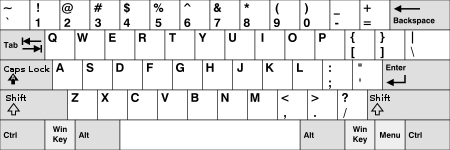Caps Lock: Difference between revisions
→Cultural significance: No need to plug one company's product in particular when talking about an attribute that many have. (Non-neutral) |
→Shift lock: A little more encyclopedia grammar |
||
| Line 16: | Line 16: | ||
== Shift lock == |
== Shift lock == |
||
Although a '''shift lock''' key is not the same thing as a caps lock key, it is nowadays rare for a computer to have both. For instance, the [[Commodore 64]] had a '''shift lock''' but no [[caps lock]]: by depressing the key labeled '''Shift Lock''', it latched and stayed that way until unlatched, and brought up again. |
Although a '''shift lock''' key is not the same thing as a caps lock key, it is nowadays rare for a computer to have both. For instance, the [[Commodore 64]] had a '''shift lock''' but no [[caps lock]]: by depressing the key labeled '''Shift Lock''', it latched and stayed that way until unlatched, and brought up again. With the C-64, there was no scan code associated with the shift lock key because it served only one purpose - grounding all of the keyscan lines as though the Shift Key were being pressed. |
||
Some [[operating system]]s and [[window manager]]s allow '''caps lock''' to be used for a similar function. This behaviour of the Caps Lock survives, however, in German and Austrian keyboards. |
Some [[operating system]]s and [[window manager]]s allow '''caps lock''' to be used for a similar function. This behaviour of the Caps Lock survives, however, in German and Austrian keyboards. |
||
Revision as of 16:38, 19 May 2010
This article needs additional citations for verification. (October 2009) |

The caps lock is a key on a computer keyboard. Pressing it will set a keyboard mode in which typed letters are capitalised by default and (on some computers) in lower case when the shift key is pressed; the keyboard remains in this mode until caps lock is pressed again.
Cultural significance

Case sensitivity, a feature used in passwords to increase their security, can also conflict with caps lock. Many services and pages that utilise this feature warn the user up front to check the status of the caps lock function before entering a username and/or password. FAQ pages and other help guides also include this advice to reduce the incidence of complaints to support technicians for such a minor and easily-prevented issue. In Windows' login screens, a warning is shown in the form of a balloon, to notify the user. In Mac OS X, when caps lock is engaged at a login or authentication panel, a symbol for caps lock (⇪) warns of the state from within the password field.
The keyboards of many early computer terminals, including the ASR-33 Teletype and Lear-Siegler ADM-3A, and early models of the IBM PC, positioned the Ctrl key where Caps Lock resides on modern keyboards. The undesirable attributes of Caps Lock have led some power users to swap the positions of the two keys using aftermarket modifications; in the same vein, the One Laptop Per Child computers opt to place Ctrl in the Caps Lock position and discard Caps Lock entirely.[1]
Some manufacturers include an option in the controller software to deactivate the Caps Lock key. This behaviour allows users to decide themselves whether they want to use the Caps Lock key and prevent those who don't want to accidentally activate it when they want to use the Shift, Tab or A key.
Shift lock
Although a shift lock key is not the same thing as a caps lock key, it is nowadays rare for a computer to have both. For instance, the Commodore 64 had a shift lock but no caps lock: by depressing the key labeled Shift Lock, it latched and stayed that way until unlatched, and brought up again. With the C-64, there was no scan code associated with the shift lock key because it served only one purpose - grounding all of the keyscan lines as though the Shift Key were being pressed.
Some operating systems and window managers allow caps lock to be used for a similar function. This behaviour of the Caps Lock survives, however, in German and Austrian keyboards.
On modern QWERTY keyboards, though the caps lock mode capitalises letters, it does not affect other keys, such as numbers or punctuation, in the way that the shift key does. A version of caps lock that affects all keys as though it were a shift key does exist on certain layouts such as the French AZERTY and those of some older computers. The origin of the function is found on mechanical typewriters, where the shift key causes the entire type apparatus to elevate upwards, physically shifting to produce capitals and secondary characters.
References
- ^ Don Marti (2006-10-27). "Doing it for the kids, man: Children's laptop inspires open source projects". Linux World. Retrieved 2007-07-23.
External links
- Wiki:CapsLockOff describes how to remap the caps lock key for other purposes.
- CAPSoff Official Website
- ihATEtHEcAPSlOCKkEY.COM provides a tool for disabling the caps lock key.
- Disable Caps Lock using a registry file.
- CapSee caps lock notification bezel for Mac OS X
| Esc | F1 | F2 | F3 | F4 | F5 | F6 | F7 | F8 | F9 | F10 | F11 | F12 | PrtScn/ SysRq |
Scroll Lock |
Pause/ Break |
|||||||||
 |
Insert | Home | PgUp | Num Lock |
∕ | ∗ | − | |||||||||||||||||
| Delete | End | PgDn | 7 | 8 | 9 | + | ||||||||||||||||||
| 4 | 5 | 6 | ||||||||||||||||||||||
| ↑ | 1 | 2 | 3 | Enter | ||||||||||||||||||||
| ← | ↓ | → | 0 Ins |
. Del | ||||||||||||||||||||
